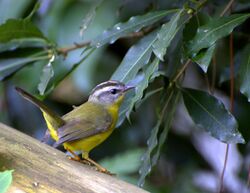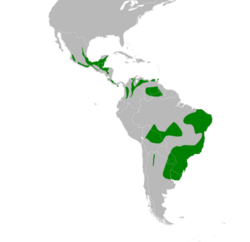Biology:Golden-crowned warbler
| Golden-crowned warbler | |
|---|---|

| |
| Scientific classification | |
| Domain: | Eukaryota |
| Kingdom: | Animalia |
| Phylum: | Chordata |
| Class: | Aves |
| Order: | Passeriformes |
| Family: | Parulidae |
| Genus: | Basileuterus |
| Species: | B. culicivorus
|
| Binomial name | |
| Basileuterus culicivorus (Deppe, 1830)
| |

| |
| Range of B. culicivorus | |
The golden-crowned warbler (Basileuterus culicivorus) is a small New World warbler.
Distribution and habitat
It breeds from Mexico and south through Central America to northeastern Argentina and Uruguay, and on Trinidad. It is mainly a species of lowland forests.
Description
The golden-crowned warbler is 12.7 cm (5.0 in) long and weighs 10 g (0.35 oz). It has grey-green upperparts and bright yellow underparts. The head is grey with a black-bordered yellow crown stripe, a yellow or white supercilium and a black eyestripe. Sexes are similar, but the immature golden-crowned warbler is duller, browner and lacks the head pattern other than the eyestripe.
Taxonomy
Golden-crowned warbler has 13 geographical races, which fall into three groups. The Central American culicivorus group (known as the stripe-crowned warbler) is essentially as described above, the southwestern cabanisi group (known as Cabanis's warbler) has grey upperparts and a white supercilium, and the aureocapillus group (known as the golden-crowned warbler) of the southeast, which has a white supercilium and orange-rufous crown stripe.[2] The three groups are sometimes considered to be different species.
Behaviour
These birds feed on insects and spiders. The song is a high thin pit-seet-seet-seet-seet, and the call is a sharp tsip. It lays two to four rufous-spotted white eggs in a domed nest in a bank, often by a forest path, or under leaves on the forest floor. Parent birds will feign injury to distract potential nest predators.
References
- ↑ BirdLife International (2020). "Basileuterus culicivorus". IUCN Red List of Threatened Species 2020: e.T103801509A139147079. doi:10.2305/IUCN.UK.2020-3.RLTS.T103801509A139147079.en. https://www.iucnredlist.org/species/103801509/139147079. Retrieved 11 November 2021.
- ↑ Phelps, Justin; Contreras-González, A.M.; Rodríguez-Flores, C.; Soberanes-González, C.; Arizmendi, M.C.; Jaramillo, Alvaro (2012). "Identification – Golden-crowned Warbler (Basileuterus culicivorus)". in Schulenberg, T.S.. Ithaca: Cornell Lab of Ornithology. http://neotropical.birds.cornell.edu/portal/species/overview?p_p_spp=578636.
- Curson, Jon; Beadle, David; Quinn, David (1994). New World Warblers. Houghton Mifflin Harcourt. ISBN 0-7136-3932-6.
- ffrench, Richard (1991). A Guide to the Birds of Trinidad and Tobago (2nd ed.). Comstock Publishing. ISBN 0-8014-9792-2.
- Hilty, Steven L (2003). Birds of Venezuela. London: Christopher Helm. ISBN 0-7136-6418-5.
External links
- Golden-crowned warbler photo gallery at VIREO (Drexel University)
Wikidata ☰ Q1535791 entry
 |


